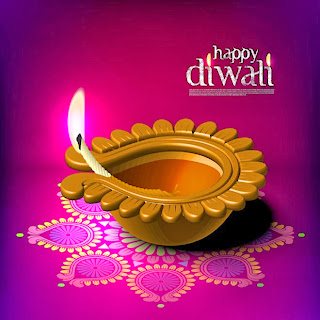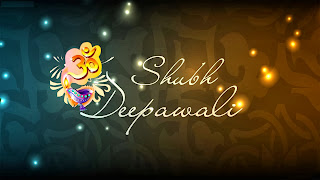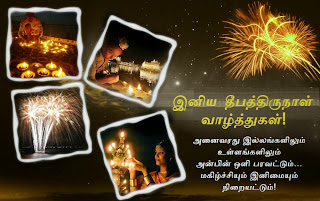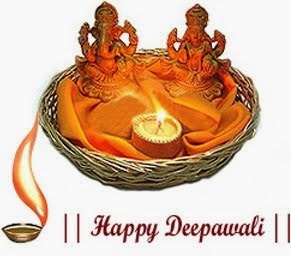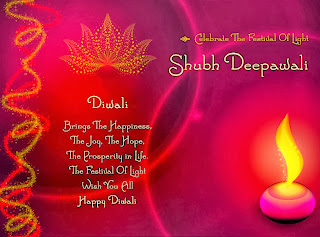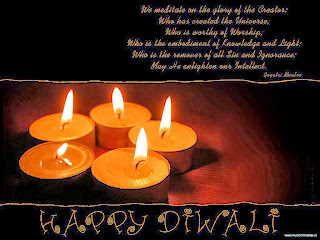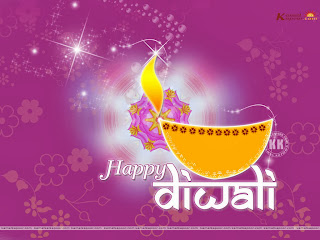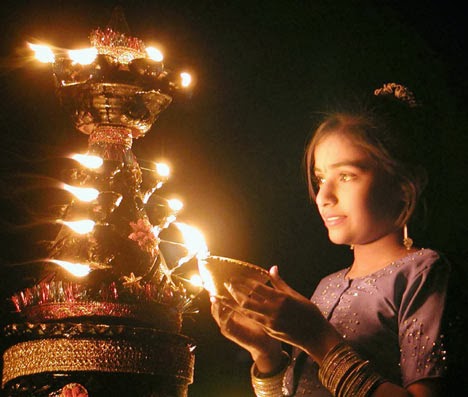Monday, October 28, 2013
Diwali / Deepavali in India
Diwali / Deepavali in India
Diwali (Dīvali, Dīpāwali, Deepavali, Dipabali) is a festival of lights and is a gazetted holiday in India. Followers of Buddhism, Hinduism, Jainism and Sikhism observe various customs related to Diwali.
People in different regions in India may
celebrate Diwali on various dates. This is because traditional lunar calendars
can be interpreted in different ways. For example, Deepavali in Tamil Nadu is
celebrated in the Tamil month of Aipasi.
Background
Deepawali or Diwali is a festival of lights
symbolizing the victory of righteousness and the lifting of spiritual
darkness. The word “Deepawali” refers to rows of diyas, or clay lamps.
This is one of the most popular festivals in the Hindu calendar. It is
celebrated on the 15th day of Kartika, according to the Hindu calendar. This
festival commemorates Lord Rama's return to his kingdom Ayodhya after
completing his 14-year exile. The myths around Rama and Ravana are told during
another holiday, known as Dussehra or Vijaya Dashami.
The Goddess Lakshmi was Vishnu’s consort and she
symbolizes wealth and prosperity. She is also worshipped on Diwali. This
festival is celebrated in West Bengal as "Kali Puja", and Kali,
Shiva's consort, is worshipped during Diwali. The Diwali festival in southern
India often commemorates the conquering of the Asura Naraka, a king of Assam
who imprisoned many people. It is believed that Krishna freed the prisoners.
Many Buddhists in India mark anniversary of the
Emperor Ashoka’s conversion to Buddhism around the time of Diwali. Many
scholars believe that Ashoka lived between 270BCE and 232 BCE. Many people who
observe Jainism mark the anniversary of Mahavira's (or Lord Mahavir) attainment
of nirvana on October 15, 527 BCE. Mahavira established the central spiritual
ideas of Jainism. Many Jains celebrate the Festival of Lights in his honor.
Bandi Chhorh Divas, which is the Sikh celebration
of the sixth Nanak's (Guru Har Gobind) return from detention in the Gwalior
Fort, coincides with Diwali. This coincidence has resulted in the similarity of
celebrating the day among many Sikhs and Hindus.
Symbols
Electric lights, small oil lamps made of clay and
flames are important Diwali symbols. They represent both physical and spiritual
aspects of light.
Saturday, October 26, 2013
History of Diwali
History of Diwali
Deepawali
or Diwali is certainly the biggest and the brightest of all Hindu festivals.
It's the festival of lights (deep = light and avali = a row i.e.,
a row of lights) that's marked by four days of celebration, which literally
illumines the country with its brilliance, and dazzles all with its joy. Each
of the four days in the festival of Diwali is separated by a different
tradition, but what remains true and constant is the celebration of life, its
enjoyment and goodness.
The Origin of Diwali
Historically,
the origin of Diwali can be traced back to ancient India, when
it was probably an important harvest festival. However, there are various legends
pointing to the origin of Diwali or 'Deepawali.' Some believe it to be the
celebration of the marriage of Lakshmi with Lord Vishnu. Whereas in Bengal the
festival is dedicated to the worship of Mother Kali, the dark goddess of strength. Lord Ganesha, the elephant-headed God, the symbol
of auspiciousness and wisdom, is also worshiped in most Hindu homes on this
day. In Jainism, Deepawali has an added significance to
the great event of Lord Mahavira attaining the eternal bliss of nirvana.
Diwali also commemorates the return of Lord Rama along with Sita and Lakshman from his
fourteen year long exile and vanquishing the demon-king Ravana. In joyous
celebration of the return of their king, the people of Ayodhya, the Capital of
Rama, illuminated the kingdom with earthen diyas (oil lamps) and burst
crackers.
These Four Days
Each
day of Diwali has its own tale, legend and myth to tell. The first day of the
festival Naraka Chaturdasi marks the vanquishing of the demon Naraka by Lord Krishna and his wife Satyabhama. Amavasya,
the second day of Deepawali, marks the worship of Lakshmi, the goddess of wealth in her most
benevolent mood, fulfilling the wishes of her devotees. Amavasya also
tells the story of Lord Vishnu, who in his dwarf incarnation vanquished the
tyrant Bali, and banished him to hell. Bali was allowed to return to earth once
a year, to light millions of lamps to dispel the darkness and ignorance, and
spread the radiance of love and wisdom. It is on the third day of Deepawali — Kartika
Shudda Padyami that Bali steps out of hell and rules the earth according to
the boon given by Lord Vishnu. The fourth day is referred to as Yama Dvitiya
(also called Bhai Dooj) and on this day sisters invite
their brothers to their homes.
The Significance of Lights & Firecrackers
All
the simple rituals of Diwali have a significance and a story to tell. The
illumination of homes with lights and the skies with firecrackers is an
expression of obeisance to the heavens for the attainment of health, wealth,
knowledge, peace and prosperity. According to one belief, the sound of
fire-crackers are an indication of the joy of the people living on earth,
making the gods aware of their plentiful state. Still another possible reason
has a more scientific basis: the fumes produced by the crackers kill a lot of
insects and mosquitoes, found in plenty after the rains.
The Tradition of Gambling
The
tradition of gambling on Diwali also has a legend behind it. It is believed
that on this day, Goddess Parvati played dice with her husband Lord Shiva, and she decreed that whosoever
gambled on Diwali night would prosper throughout the ensuing year. Diwali is
associated with wealth and prosperity in many ways, and the festival of 'Dhanteras' ('dhan' = wealth; 'teras' = 13th) is
celebrated two days before the festival of lights.
From Darkness Unto Light...
In each legend, myth and story of
Deepawali lies the significance of the victory of good over evil; and it is
with each Deepawali and the lights that illuminate our homes and hearts, that
this simple truth finds new reason and hope. From darkness unto light — the
light that empowers us to commit ourselves to good deeds, that which brings us
closer to divinity. During Diwali, lights illuminate every corner of India and
the scent of incense sticks hangs in the air, mingled with the sounds of
fire-crackers, joy, togetherness and hope. Diwali is celebrated around the globe. Outside India, it is
more than a Hindu festival, it's a celebration of South-Asian identities. If
you are away from the sights and sounds of Diwali, light a diya, sit
quietly, shut your eyes, withdraw the senses, concentrate on this supreme light
and illuminate the soul.
வரலாற்று சிறப்புமிக்க தீபாவளி கொண்டாட்டம்
வரலாற்று சிறப்புமிக்க தீபாவளி கொண்டாட்டம் தீபங்களின் அணிவரிசையாம் தீபாவளி பண்டிகை, பழங்காலம் முதலே
கொண்டாடப்பட்டு
இருக்கலாம் என வரலாற்று ஆராய்ச்சியாளர்கள் தெரி்வித்துள்ளனர். தீபாவளி என்றால் பட்டாசு, இனிப்பு வகைகள்,
சினிமா, லேட்டஸ்டாக இந்திய
தொலைக்காட்சிகளில்
முதல் முறையாக பார்க்கும் படம்
என எண்ணற்ற காரியங்கள் நமக்கு
தெரியும். ஆனால், தீபாவளிக்கென ஒரு
வரலாறு உள்ளது. தீபாவளி கொண்டாட முக்கிய காரணம்,
கிருஷ்ணரின் லீலை தான்
என்பது யாவரும் அறிந்ததே.
உலகில் தீய
சக்தியாக இருந்த நரகாசூரனை, வீழ்த்தி வெற்றிப் பெறுகிறார் கிருஷ்ணன். ஆனால்
அதேசமயம் அந்த தீயவனின் விண்ணப்பத்தையும் ஏற்றுக் கொள்கிறார். அதனால்
தோன்றியதான் தீபாவளி. இந்த
சம்பவத்திற்கு
பின் கிருஷ்ணன் வெற்றி
வீரனாக தனது சகோதரியின் வீ்ட்டிற்கு செல்கிறார். அங்கு
அவருக்கு உற்சாக வரவேற்பும், இனிப்பும் வழங்கப்படுகிறது. இதனால்
தான், தீபாவளியன்று அனைவரும் நண்பர்கள், உறவினர்களிடையே இனிப்புகள் வழங்கும் பழக்கம் தோன்றலானது.
தீபாவளி இந்தியாவில் மட்டுமல்ல, நமது
அண்டை நாடுகளான வங்காளதேசம், இலங்கை,
மலேசியா உள்ளிட்ட நாடுகளிலும் கொண்டாடப்படுகிறது. ஆனால்,
பெயர்களும் கொண்டாடும் முறைகளிலும் மாற்றம் உள்ளது.
தமிழ் மன்னர்களுக்கு பண்டைய
காலத்தில் ரோம், எகிப்து, பாபிலோன், கிரேக்கம், பாரசீகம் என
பல உலக நாடுகளுடன் வர்த்தக தொடர்பு இருந்தது. செழிப்பான இந்தியாவில் இருந்து வாசனை
திரவியங்கள், மூலிகைகள், தந்ததங்கள், ஏன்
குரங்குகள் கூட கொண்டு சென்றதாக வரலாற்றில் கூறப்பட்டுள்ளது. அந்த
வணிக தொடர்பின் போது,
இந்தியாவில் இருந்து சென்ற
பல வாணிகர்களும் தாங்கள் இருந்த
இடத்தில் பொங்கல், தீபாவளி பண்டிகைகளை கொண்டாடி உள்ளனர். இதனால்
அங்கும் இந்திய கலச்சாரம் பரவ
ஆரம்பித்தது. மேலும் இந்தியாவில் பேரரசர்களாக இருந்தவர்களும் மக்களின் விருப்பத்தை ஏற்று,
தீபாவளியை சிறப்பாக கொண்டாடி உள்ளனர். சில
மன்னர்கள் அதற்காக போட்டிகளையும், வீர
விளையாட்டுகளையும்
நடத்தி இருக்கலாம் என
வரலாற்று ஆசிரியர்கள் நம்புகின்றனர். ஆனால்,
இந்தியாவை ஆட்சி செய்த
ஆங்கிலேயர், பிரஞ்சு, டச்சு
அதிகாரிகள் மக்களின் கொண்டாட்டங்களில் அதிகம்
விருப்பம் காட்டியதாக தகவல்கள் இல்லை.
முகாலய மன்னர்களில் சிலர்
கூட தமிழர் பண்டிகைகளை ஆதரித்தாகவும், பசியாக
வந்தவர்களுக்கு
விருந்து அளித்ததாகவும் குறிப்புகள் உள்ளன.
ஆனால் பண்டைய காலங்களில் பட்டாசு வெடித்து கொண்டதற்கான ஆதாரங்கள் இல்லை.
வெடி வெடிக்கும் பழக்கம், சந்தோஷத்தை குறிப்பதற்காக ஆரம்பித்திருக்கலாம் என
நம்பப்படுகிறது.
பண்டைய நாட்களில் இலை மற்றும் வெடிமருந்து கொண்டு தயாரித்து வந்துள்ளனர். அதன்பின் வெடியிலேயே பல வகைகளில் வந்து, இப்போது வெடிச்சது போதுமப்பா, புகை நெடி தாங்க முடியவில்லை, வெடிக்கவே வேண்டாம் என்று சொல்லும் அளவுக்கு வெடிகள் ரொம்பவே அட்வான்ஸ் ஆகி விட்டது. தமிழர் பரம்பரையும், பண்டைய வழக்கங்களும் தொண்டு தொட்டு பின்பற்றப்பட்டு வருகின்றன. இந்நிலையில், தீபாவளி கொண்டாட்டத்திலும் தமிழ் பாரம்பரியம் விளங்கும் வகையில் தமிழர் ஆடை உடுத்தி கொண்டாடலாம் என்பது மறைமுக கோரிக்கை.
Subscribe to:
Posts (Atom)

